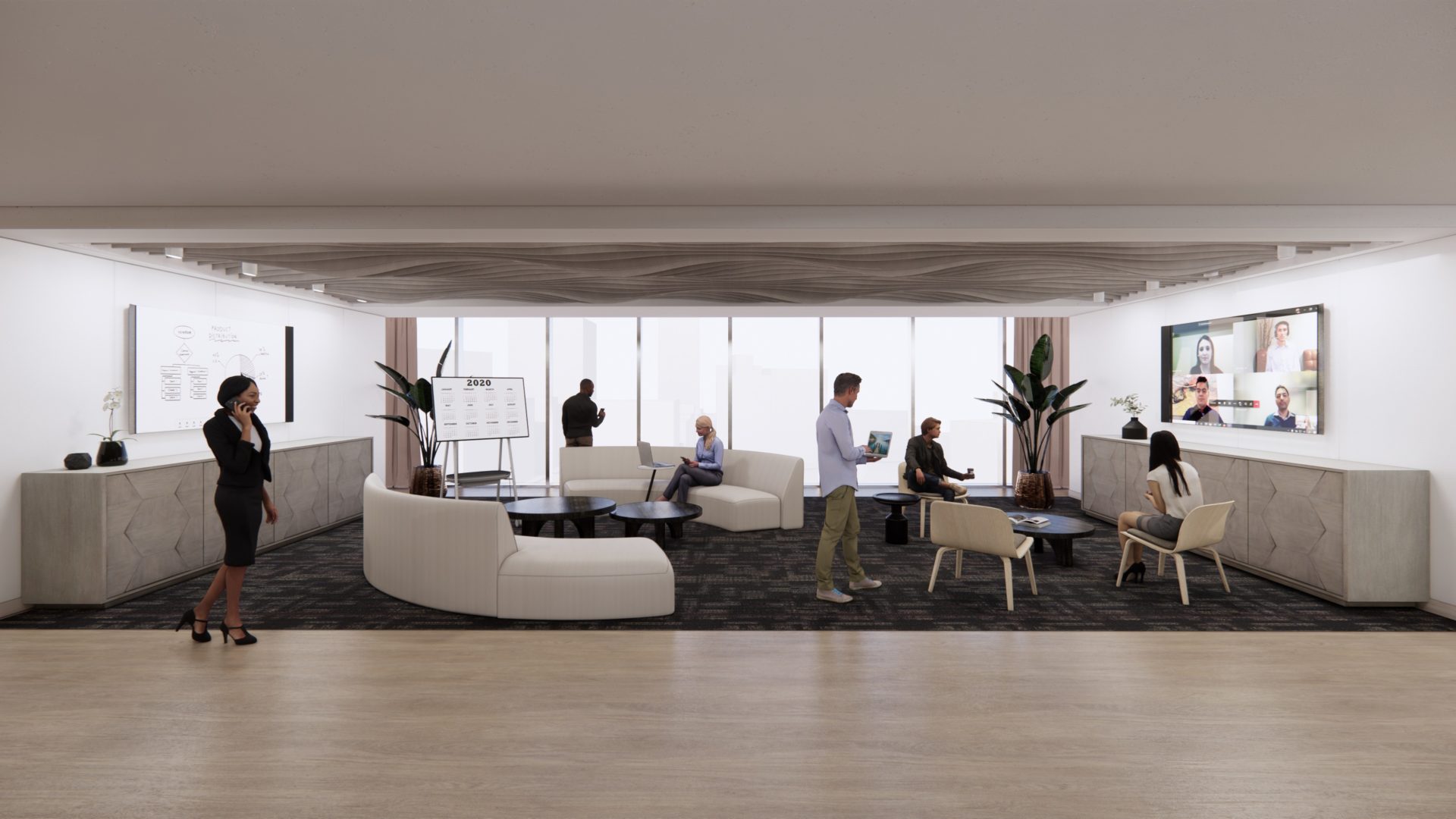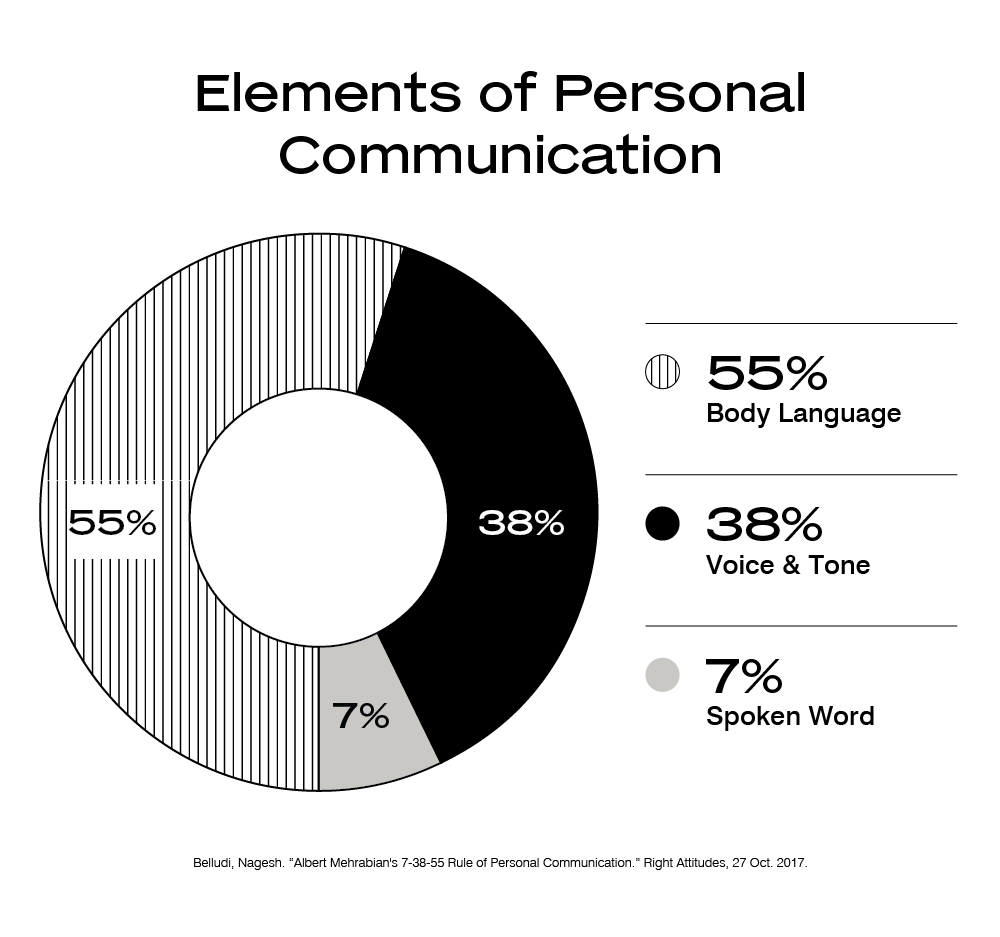Creating a Virtual First
Workplace Ecosystem
 Read Below
Read Below
 Read Below
Read Below
Rendering created by the Pophouse team
Creating a Virtual First
Workplace Ecosystem
Welcome to the second in Pophouse’s series of articles addressing the concept of the Future of Work. Known for creating transformational spaces for clients in the commercial, hospitality and retail industries, Pophouse is a Detroit-based interior design studio that creates unconventional and human-centric design. We have assembled our team of interior, industrial and environmental graphic designers and strategists to address the issue of creating what we are calling a “virtual first workplace ecosystem.” Due to the fundamental shifts anticipated within the office environment caused by the COVID-19 pandemic, we feel this topic takes on new urgency as some workers start returning to the office while others continue to work remotely.
What is a Virtual-First Workplace Ecosystem?
What does “virtual-first ecosystem” mean? It is a phrase we came up with to define the modality of the workplace. A term used primarily in reference to healthcare and education, where consumers have traditionally needed to be physically present to receive information, “virtual-first” now recognizes that a service provided by a computer over a network can represent a viable and valuable approach to delivery. Defined as “any system or network of interconnecting and interacting parts,” the term “eco-system” perfectly describes how we at Pophouse view the workplace.
We anticipate that the new office environment will necessarily include a workforce comprised of those present at the office and those who work remotely. We envision an ideal office environment whose design takes the virtual-first dynamic into consideration, in which about half of team members may be telecommuting. Now is the time for you to consider that many of your team members will not be physically present in the office of the future, so you should create an environment in which all workers can participate on a level playing field.
Anna Okerhjelm, Design Director at Pophouse states, “There is a heightened level of empathy apparent during this time as individuals are facing varying hardships due to this pandemic. We are all recognizing within our own teams, this new capacity for understanding and care for those we work with on a daily basis. It’s important we maintain this level of empathy as we build for a more fluid and seamless experience when bringing people back to our physical environments to support a blend of workstyles and presence. This certainly entails a cultural shift in mindset and habits, however, by paying close attention to the details and cues of the physical space, we can succeed in working both together and independently, from anywhere.” This empathetic approach puts the human-centric experience first, anticipating the nuances of team member needs. Establishing practices and offering guidance on how meetings should be run are a priority. You must also make sure that the office environment — physical, virtual and cultural — supports your protocols and policies, so those who are not physically present do not feel left out.
We are all recognizing within our own teams, this new capacity for understanding and care for those we work with on a daily basis.
The Physical Layout of the Future Office
We call it an “ecosystem” because office space should be designed with a consideration of how, when, where and why people work at their optimum capacity. We foresee the need for a variety of configurations of space to support different types of work. According to Sarah Davis, Pophouse’s Business Intelligence Account Director, “providing a spectrum of communal spaces to support individuals through many rituals and types of work in the landscape creates a collection of spaces to leverage. This promotes engagement and productivity while also maximizing the value of the office space to emphasize team performance.” Sarah believes that with a focus on bringing in remote team members, a variety of configurations will support the different workstyles of both present and virtual employees.
Sarah continues, “Curating an office environment with the flexibility to align in-office and remote work will be paramount. Incorporating layers of technological integration that promote and enhance the ease of working together, no matter how many individuals are physically present, will allow teams to keep positive momentum.”
A Level Playing Field and Company Culture
In the past, the majority of office workers held meetings in a conference room, with perhaps one lone team player joining in remotely. In the new office environment, one in which multiple people, if not everyone, may be working from home, a level playing field for virtual work has been created, albeit inadvertently. As a result, everyone is experiencing the same challenges created by the new normal. But when some of those team members return to the office, that playing field could be shaken up again. Care must be taken to ensure that the office is designed in a fluid way to accommodate changes as the aftermath of the pandemic starts to take shape.
Feeling connected to others and having a sense of belonging are fundamental human needs, so working remotely and social distancing can have a negative impact on workers’ well-being over time. Mobile workers often miss out on being part of office culture. For those who will not be returning to the office on a full-time basis, frequent virtual meetings will help everyone feel more connected. Scheduling regular occurrences when everyone can come together at the office, whether weekly, monthly or quarterly, will help to foster a sense of community and common purpose.
A plan should be devised so workers know when and how to reach one-another. This can be accomplished by establishing hours that all team members will be available to each other and expected that they respond to each other within a specific time period.
Having the Right Technology
A virtual-first environment needs to offer proper acoustics and ease of connectivity. Even in the absence of technical glitches, sound issues such as background noise, echoes and missed words and phrases are a leading cause of virtual meeting problems. A lack of the right equipment can have a negative impact on workplace efficiency and morale.
As mentioned in our last article, an investment in improved technology is essential to make communication among employees as seamless as possible. A conference call used to mean dialing from a phone in the center of the conference room table and putting it on speakerphone. Fortunately, the technology for making remote group communication possible has vastly improved so now it is relatively simple to get all systems up and running. New advances in audio technology such as Audio-over-IP and AI voice capabilities are helping to solve the acoustic considerations of virtual meetings.
In addition to addressing the issue of acoustics, business owners and managers must provide the necessary technology to team members who work from home. Remote workers are often expected to supply their own devices, which can slow down production and create security issues. Your remote staff should have the resources needed to effectively do their jobs. All employees should have access to proper training and technological support from home must be available on an on-going basis.
Experimentation with various platforms and a combination of different tools should result in your finding the right solution for your company. Whether a team member is working remotely or in the office, the use of consistent tools will increase communication and boost productivity, leading to better team cohesion.
Don’t Forget the Visuals
In order to guide team members on what to expect and to help overcome challenges with connecting, best practice guidelines need to be established regarding how meetings are to be conducted. This should include rules of etiquette; for example, whether participants should be allowed to mute out the proceedings or opt out of appearing on camera.
It can be frustrating for team members who are not in the office, with challenges such as not being able to hear properly, not making eye contact, not being able to ‘read the room,’ and feeling left out as a result. These shortcomings could potentially result in a fait accompli, confirming team managers’ belief that remote meetings cannot possibly work.
Fortunately, today’s technology can provide more than adequate video conferencing, an important tool in improving and maintaining collaboration, with participants able to see one another as well as share content. In addition, when people can actually see each other, they can interpret body language and expressions and respond in kind. According to Albert Mehrabian’s 7–38–55 Rule of Personal Communication, words, tone of voice, and body language respectively account for 7%, 38%, and 55% of personal communication this data further emphasizes the importance of visuals.

Summary
In conclusion, the Future of Work is about outcomes. According to Jennifer Janus, President of Pophouse, “As a design firm, addressing the people part of the equation is our first priority. Allowing team members more flexibility to work remotely can lead to an increase in productivity and well-being if the office space is designed from a virtual-first mindset. Streamlined technology, proper acoustics and collaboration spaces as well as clear guidelines around meeting protocols will set up your mix of remote and in-office team members for long term success.”
Next Story
